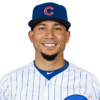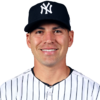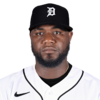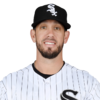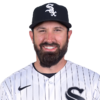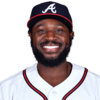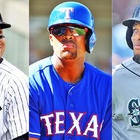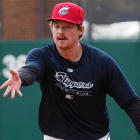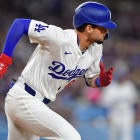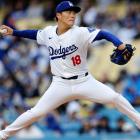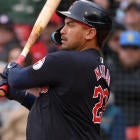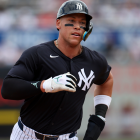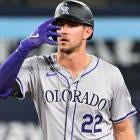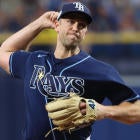The mean man is back, ready to dash all your hopes and dreams with a dose of sober reality.
You may approach your draft with all the buoyancy of a Lincoln Log, but I see it for the sinkhole that it is, complete with all its toils and snares.
I have softened my stance on some of bust picks from earlier this offseason, recognizing with the newly available draft data that they're not such bad value after all. However, I've introduced some new busts in their place -- ones that will make you question everything you thought you knew about drafting.
To the bustmobile!
Note: Average draft position, assuming a 12-team league, is shown for both Rotisserie and Head-to-Head formats above each player's name.
The Newcomers
You like what Kyle Schwarber did down the stretch for the Cubs last season, homering 16 times in 69 games? Just imagine how his numbers would compare to other catcher-eligible players' if he played every day.
Problem is he won't play every day. The Dexter Fowler signing assured it. That is, unless the Cubs are are giving up on Jorge Soler and Javier Baez, which would be uncharacteristically rash. They're both right-handed hitters, so sitting the guy who hit .143 against left-handers last season (i.e., Schwarber) would make sense.
What it means, though, is that the 23-year-old's situation isn't even as favorable as Evan Gattis' was last year.
Oh, you remember that, do you? Yes, Gattis, who still had catcher eligibility at the time, was expected to DH every day for the Astros, and based on his numbers as a part-timer for the Braves, some of us were projecting 30, 35 or even 40 home runs for him. That sort of production was so far above what any legit catcher could accomplish because of the rest required at the position that Gattis was drafted in the fourth round on average.
Say, would you look at Schwarber's ADP?
Gattis still had 27 home runs and 88 RBI, so he wasn't an outright disaster, but the production didn't live up to the hype or the ADP. And that's where I fear we're headed with Schwarber -- perhaps even more disastrously because of the playing time concerns.
It's not the cleanest comparison because Gattis wasn't an especially hyped prospect coming up through the minors. He didn't have the pedigree of a fourth overall draft pick and didn't get a chance to strut his stuff on a postseason stage.
But where Schwarber trails Gattis may be even more significant. He strikes out a ton. His rate of 28.2 percent would have ranked seventh if he had the at-bats to qualify, and that condemns him to about the batting average he had last year.
So really, he needs to maintain last year's 35-homer pace to rank as far ahead of the rest of the catcher crop (Buster Posey aside) as he's being drafted, and that's too much to ask of any part-timer.
I had no problem drafting Robinson Cano where I thought he would go. Even saw the upside to it based on the way he finished last season.
You saw that finish, right? The .331 batting average, 15 home runs and .926 OPS in the second half? Yeah, it was pretty special -- reminiscent of the Cano of old, even. And his average draft position would suggest there's more than a glimmer of hope that the Cano of old has indeed returned.
But, then, where was he the first year and a half in Seattle?
This is no small issue to me given that most middle infielders are well into their decline by age 33. And I'm not sure that a terrific half-season means Cano himself isn't.
We've spent most of the last two years fretting over his diminished power. A strong finish saved him both times, but maybe we should take it as a sign that we're playing with fire, that he's not as reliable as he used to be whether from month to month or year to year, and that one of these years he's not going to have the late surge that bails him out.
Here's an even clearer sign: Last year, Cano's 6.4 percent walk rate was among the lowest of his career, and his 15.9 percent strikeout rate was by far the highest. You don't need to know any other stats to know that's a player on the wrong side of the developmental curve.
Why take the chance so early in a year when so much talent is available at second base? In Head-to-Head points leagues, players like Joe Panik, Dustin Pedroia, Daniel Murphy and Brandon Phillips outscored Cano on a per-game basis last season, so even with the second-half bailout, he's not the player he once was.
To understand the enthusiasm surrounding Khris Davis this draft season, you need look no further than our SportsLine projections, which have him hitting 34 home runs in 561 at-bats for his new team. I think anyone would take those numbers in the 15th round of a Rotisserie draft. I still think Round 11 is too early in a Head-to-Head points league, where he needs a little something else to make up for his high strikeout rate, but hey, 34 homers are 34 homers.
The question is can he honestly hit that many?
If you project out last year's number, OK fine, he's there. But consider how he arrived at last year's total. He hit 20 of his 27 home runs in his final 53 games -- a pace that would be unsustainable for even the other Chris Davis. And I know for other players I've pointed to a late-season surge as a signal for a breakout, but this particular player has a record of streakiness and little historical precedent for this sort of breakthrough.
He made a name for himself down the stretch in 2013 with nine home runs in 31 games. And so what happened the following year? He hit 22 in 144 games. Oh, but he had those 10 during a 34-game stretch from mid-May to late June and those six during a 24-game stretch from mid-July to mid-August, so if you caught him at the right time, you might have mistaken him for one of the game's preeminent power hitters.
The end of last season caught him at the right time.
He never got a chance to regress to the mean, to slow his home run pace to something closer to 2014, and that Khris Davis was more along the lines of a Marlon Byrd.
Even if you're willing to assume a modest power increase, he's going from one of the best parks for home runs to one of the worst, which could neutralize any gains he made skills-wise. I'd much rather have Mark Trumbo, a more proven source of power with similar shortcomings who tends to be drafted later.
The Holdovers
No one would argue Lorenzo Cain was a stud last year, but what we have to consider is all that went in to making him a stud.
Emphasis on the "all."
He was one of those players who did a little of everything (and maybe more than that in batting average), which means any letup anywhere could ruin the whole thing.
Don't believe me? Just compare his 2014 numbers to last year's. The biggest difference was the home runs, and yet one year he was a top-12 outfielder in both formats and the other he was barely top-40 -- the difference between an early-rounder and a late-rounder, basically.
Age 29 is a little late for a power breakthrough, especially since Cain had no real buildup over his first five major-league seasons. I'd say the chances of him continuing it are better than 50-50, but since his lofty price tag depends on it, skepticism is warranted.
So wait ... Carlos Gonzalez stays healthy for 150 games for the first time in his career after averaging 110.5 games in the previous four seasons, and just like that, we're supposed to forget he's one of the most injury-prone players in baseball?
Surely his inconsistencies aren't lost on anyone. Of his career-high 40 home runs last year, 30 came in the final three months for a .990 OPS then compared to .715 in the first three. Granted, you'd rather see him end on the high note than the low one, but for a player who's so often off key, the contrast is unsettling regardless.
Investing in him not only relies on him staying healthy, but also disclosing and seeking proper treatment if he doesn't. You'd hate for his numbers to be compromised by injury and not even know it, as happened in 2014. And if the career .255 hitter with a .752 OPS on the road follows Troy Tulowitzki out the door, all bets are off.
Big power or not, that's too many potential pitfalls for an early-round pick.
Avoiding the Tommy John specter is a paranoid and often self-defeating way of playing Fantasy Baseball, but in Johnny Cueto's case, the signs are so obvious that it's a wonder any team would give him a nine-figure contract this offseason.
The fact one did may suggest something, but it doesn't change that Cueto pitched most of 2015 with a balky elbow -- an injury that dated back to May -- and saw his production decline as a result. At the time the Reds traded him to the Royals in late July, he had an ace-like 2.62 ERA, 0.93 WHIP and 8.3 strikeouts per nine innings through 19 starts. Thereafter, he had a 4.76 ERA, 1.45 WHIP and 6.2 strikeouts per nine innings over 13 starts.
Some will blame his move from the NL to the AL since that's when the biggest drop-off occurred, but facing another hitter every time through the order doesn't explain the drop in strikeout rate. Cueto had also lost a couple miles per hour on his fastball by the time the playoffs rolled around.
Considering he never got a chance to rest the elbow, the injury, which was dubbed "inflammation" at the time, would seem to be a more plausible explanation for his struggles even though the timing seems off. The effects may have been cumulative rather than instantaneous. And as many times as a partially torn ligament has gone undetected, the fact that Cueto passed his physical with the Giants doesn't put my mind at ease.
With two dozen other ace-caliber pitchers available, why take the chance on him in the early rounds?
You knew we'd eventually reach the point where we couldn't keep recommending Adrian Beltre on Draft Day, and 2016, his age-37 season, is that point.
Now, maybe you could argue it's a year too late, but last year's Beltre owners were pretty satisfied with him in the end. You might even say he carried them in the second half, batting .318 with 11 home runs and an .884 OPS to give him the eight-most Head-to-Head points per game at the position overall.
But for a player his age, the trends are telling. His slugging percentage declined for the third straight season, this time by about 40 points, and now he's not even a safe bet for 20 homers, much less 30.
If the age-36 Beltre shows up again, he's a serviceable starter in mixed leagues and well deserving of a middle-round pick, but he's actually going in the early rounds. That's bad enough, but if the age-37 Beltre continues down the same path, much like a declining Aramis Ramirez last year in his age-37 season, he's quite possibly waiver fodder.
You don't have to try too hard to convince yourself Brandon Crawford's power breakthrough last year was legitimate. His 21 home runs were distributed almost evenly over the course of the season, and his average fly ball distance ranked ninth among all hitters, up from 152nd in 2014.
But are you comfortable staking a middle-round pick on it? Even with the 21 homers -- which were second only to Carlos Correa among shortstops, by the way -- he ranked only eighth at the position in Head-to-Head points per game. He brought literally nothing else to the table, and that's not likely to change.
As funny as it sounds coming off what most would describe as a breakthrough season, Crawford is actually on the verge of his decline phase at age 29. Some of the most notable Fantasy shortstops in recent memory -- from Nomar Garciaparra to Edgar Renteria to Rafael Furcal -- crashed and burned within a year or two of their 30th birthdays, with Jose Reyes and Troy Tulowitzki potentially following suit. It's a position that can wear down a player. The Derek Jeter and Jimmy Rollins types who remain productive into their mid-30s are the rare ones -- and usually Hall of Fame caliber.
Plus, shortstop is no longer so thin that you have to reach for anyone who offers the faintest hope of production. Eugenio Suarez's power surge last year followed a more typical progression than Crawford's, and he's still available half a draft later.
It has become standard operating procedure with Jacoby Ellsbury. When he has an injury-plagued year, as he's wont to do, you draft him as you normally would the following year because he always -- always -- bounces back.
The difference this year is that he already had a chance to bounce back, returning from a sprained knee for the final three months, and didn't, batting .224 over his final 304 at-bats. As you know, batting average can be misleading, but for the third straight year, Ellsbury set a career high in strikeout rate, with this one being his biggest jump yet. He also had more swings and misses than ever, which would suggest diminishing bat skills -- a plausible development for an injury-prone 32-year-old.
Worst of all, his 21 stolen bases in 111 games were only slightly better than pedestrian. Pure speedsters tend to age quickly, and that's what Ellsbury has proven to be over his career, apart from an outlier 2011 season. If he can't deliver on batting average either -- and he has hit only .276 over the last four years -- he'll struggle to perform like a top 30 outfielder.
A snoozer pick? Well, I've always felt like the Yankees home unis look especially like pajamas on Mark Teixeira.
The soon-to-be 36-year-old did have a resurgent first four months last year, delivering the same elite home runs and walks package that defined his first two seasons in New York, only to miss the final two months -- most of them, anyway -- with a bone bruise in his shin. And you might say that was all the reminder we needed that he's old, brittle and not to be trusted.
The way first base stacks up this season, though, somebody will have to trust in him.
It's surprisingly thin. With Prince Fielder and Kendrys Morales confined to DH to begin the year, there aren't 12 mixed league-caliber options to go around. Teixeira was certainly of that caliber for the time he was healthy last season, but then again, he was never of that caliber in two years prior and, even last year, made his owners feel like they were flirting with disaster before he went down.
The time to flirt with disaster is when you're filling holes off the waiver wire midseason, not in the middle of your draft. Better to settle for a second-rate Carlos Santana or Lucas Duda a few rounds later than pay up for Teixeira.
First, let's make sure we have the timeline right.
Michael Pineda begins 2015 where he left off 2014, looking fully recovered from his past injuries and like one of the best up-and-coming pitchers in the American League. Over his first 17 starts, he has a 3.64 ERA, 1.20 WHIP and 9.4 strikeouts per nine innings, emerging as Fantasy mainstay and even earning a trip to the All-Star game.
Then, he has a couple of bad starts, and the Yankees put him on the DL with a strained forearm. He rests for about a month, but after returning, he's worse than ever, compiling a 5.48 ERA in eight starts.
Now, pitchers sometimes get sore forearms, and most return from them as right as rain. The ones who don't often don't because their forearm injuries are actually elbow injuries -- which is how Pineda's was initially classified, by the way -- and those elbow injuries often lead to ligament replacement.
The whole situation reminds me of the way Yu Darvish ended 2014, and we know how that turned out. Connecting those dots may seem like an alarmist response, but given Pineda's injury history and heavy reliance on the slider (an elbow killer if there ever was one), not to mention the sour taste he left our mouths, why take the chance?
Marco Estrada apparently earned the Blue Jays' trust with a steady performance down the stretch and into the playoffs last year, netting a two-year, $26-million contract this offseason. But the performance puts his career path even more closely in line with Ricky Nolasco's, which makes me fearful of what comes next.
Both were once perennial Fantasy sleepers because of stellar strikeout-to-walk ratios, but then when they finally turned in a season befitting the hype (after it had already died down, for the most part), the strikeouts were strangely missing. Estrada's 6.5 strikeouts per nine innings last year ranked 64th among the 78 qualifying pitchers despite an ERA that ranked 17th and a WHIP that ranked ninth, which leads me to believe that as a fly-ball pitcher in a hitter-friendly park, he really dodged a bullet.
Remember: He's only a year removed from a disastrous season in Milwaukee when he allowed an astonishing 2.3 home runs in nine innings before moving to the bullpen. As happened with Nolasco, losing the ability to miss bats may ultimately be what does him in.
The Dropouts
As the standard for a Fantasy ace has increased over the last few years, reaching historic heights last year, Shields' so-so ratios have kind of gotten left in the dust.
He managed to hold on a while there because his workload was so impressive. In an era when 2oo-220 innings is about the expectation for an ace, you couldn't find a safer bet for 230 or so, which at least in Head-to-Head points leagues was enough for Shields to close the gap on pitchers like Chris Sale and Madison Bumgarner.
But that 35-year-old arm of his has logged some miles now, and they seemed to catch up to him in his first season with the Padres. He went from being a seven- or eight-inning pitcher to going six innings more often than not, eliminating that little advantage he had over the rest of the starting pitcher crop. And while an uncharacteristically high strikeout rate sustained him in the first half, it came at the expense of an inflated walk rate and mostly normalized in the second half, leaving him with numbers more like you'd expect from A.J. Burnett.
While that sort of production still has value in Fantsay, it reduces Shields from a borderline ace to no more than a No. 3 starting pitcher in Fantasy. You wouldn't want to overpay for the name, especially with another year of mileage on that arm.
Reason for removal: So Shields produces more like a No. 3 Fantasy starting pitcher than an ace, huh? Well then, I should be thrilled he's getting drafted more like a No. 4. Hard to call him a bust if I'd be perfectly content drafting him at his going rate. Even if he's "only" a 200-inning pitcher now, a 200-inning pitcher with strikeout-per-inning potential is about as good as you can hope to find once the true aces -- meaning the top 20 or so, depending what rankings you use -- have gone off the board.
Adam Eaton, the trendiest sleeper of 2013, finally woke up last year, putting past concerns about his elbow and underwhelming steals totals to rest with the kind of across-the-board production that once made Shane Victorino a Fantasy stud.
But one area where Victorino excelled that 2015 Eaton didn't was making contact. The 27-year-old had one fewer strikeout than Mark Trumbo. It's not the fairest comparison because he also had far more plate appearances, but if you go by rate instead, he lands in the same range as Gregory Polanco and Cameron Maybin, who hit between .250 and .270 last season. While he did show improved power last year, Eaton, like those two, can't count on a high number of balls out of play -- home runs, in other words -- to pad his batting average, so it's largely determined by his number of hits in play
Sure enough, when he was hitting .335 in the second half to salvage his batting average last season, his BABIP was a wildly unsustainable .412, which makes you wonder how sustainable the whole package is. Maybe he was as unlucky in the first half as he was lucky in the second, but then again, maybe you're wasting a middle-round pick on a late-round talent who, by the way, still doesn't run enough to satisfy Rotisserie owners.
Reason for removal: It's true Eaton isn't a big home run hitter, but it wasn't only his batting average that carried him, as I seemed to suggest two months ago. Coming off a 14-homer, 18-steal season, he's one of only a handful of genuine power-speed guys -- modest though those numbers may be -- available in the middle rounds of a Rotisserie draft. Seeing him drafted alongside Brett Gardner and Dexter Fowler, neither of whom is of any help in batting average, makes sense.
It's fair to say that calling Brandon Phillips a bust prior to last season won't be going on my greatest hits album. It wasn't exactly going out a limb following a career-worst (at least with the Reds) 2014 campaign, and he responded with his highest steals total in six years and highest batting average in four to rank seventh among second basemen in Head-to-Head points leagues and fourth in Rotisserie.
But none of what worried me about him last year -- the fading plate discipline, the rising chase rate, the declining power, the advanced age (34) for a middle infielder -- has actually changed, which means he can only fall harder with expectations now raised for 2016.
It kind of reminds me of Jimmy Rollins in 2014, when he interrupted a four-year downward trend with a minor resurgence at age 35, causing the Fantasy-playing world to buy into him as a high-end shortstop again.
And how did he follow it up last year? Well, let's just say Father Time remains undefeated.
Reason for removal: So what if Phillips can only fall harder this year? He's getting drafted like last year never happened. I thought for sure a second baseman who placed in the top five in one format would be drafted like he mattered, but apparently I didn't give our users enough credit. Truth is I'm sometimes so hard up for speed late in Rotisserie drafts that he starts to look awfully attractive, especially since he might actually do some good in batting average.













